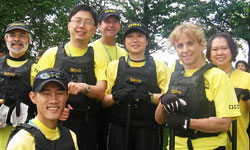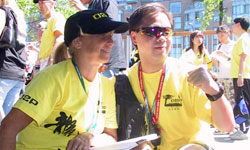
About Lisa V
| Treatment Type | Nocturnal Home Hemodialysis |
| Gender | Female |
| Age | 40s |
| Marital Status | Unmarried |
| Kids | No / Not at Home |
| Work Status | Working |
| Race | White |
| Pets | No |
| Cause | Unknown |
| Travel | No |
| Poor Vision | No |
In 1978, 12-year old Lisa and her family sought medical help because she had a rash and stomach pain. They thought she had allergies. Instead, they learned that Lisa had Henoch-Schonlein purpura (HSP). Medical science has yet to find the cause of HSP, but it usually lasts a short time and most patients recover on their own. In very rare cases—like Lisa's—HSP can cause kidney failure.
Dialysis at a young age
Lisa, a very athletic young teen, was at volleyball practice when her parents brought her the news that her kidneys had failed and she would need to start dialysis. Not long after, Lisa started on peritoneal dialysis (PD). "Back then, you went to the hospital for dialysis—even PD," Lisa recalls. "I would go from 6 am to 6 pm every other day. The idea was to do one PD exchange every hour."
"I felt right at home," she remembered. "My dad painted murals of Snoopy and Woodstock doing dialysis on the hospital walls, and the nurses were all so nice to me." Although Lisa spent a lot of time in the hospital, she stayed in school.
After 6 months of PD, Lisa had a fistula put in and switched to hemodialysis (HD). She still went to the hospital. Her new schedule was 3 evenings a week for 3-4 hours. During the day, she went to school. Lisa also started to take on some of her own dialysis care. "I learned to set up my own machine and put in my own needles," Lisa said proudly. "Back then that was very unusual...especially for a kid."
Multiple transplants
In 1979, Lisa got a transplant from her mother that lasted 10 years. During that time, Lisa got a Bachelor's in Science and traveled the world. "When my transplant began to reject, I knew it was only a matter of time before I'd be back on dialysis," Lisa says. "So, I went to Australia." She was there for almost a year before her transplant failed. When it did, she came home to Winnipeg (Canada) to begin dialysis again.
Lisa's return to dialysis was brief. Just a month later (in 1989), she got a second transplant. She started a BA in nursing program and, one summer, went to South East Asia. In 1994, Lisa moved to Vancouver to go to the University of British Columbia. She earned a Masters degree in Nursing Education and Research. In 1995, while she was at work full-time and taking an evening class, her transplant failed. To keep her job, Lisa did in-center HD in the evening and weekends. She kept up her full-time work and HD for 7 years—then got a call for a third transplant in 2002. Sadly, it lasted only 12 hours due to a technical problem.
Home training program
For almost 11 years, Lisa worked while on in-center HD. In 2001, Lisa and a group of dialysis care partners formed a dragon boat racing team. Their aim was to raise awareness of kidney disease and organ donation. The 22-person team rows their boat—called "Oh-2-P"—in races around Vancouver.
In 2005, Lisa learned that Vancouver General Hospital was starting an nocturnal hours home HD program, and was accepted. "The timing of the training classes was a big obstacle," Lisa recalls. "They were during the day, 3 days a week, and I was working full-time." Still, Lisa made the time in her workday. "I was determined," she added, "to do home dialysis." She started her work day early, at 6 am, put in a full day, then went to home HD training at 1 pm. Since Lisa had so many years of HD, plus her nursing background, her training went very quickly. "It only took me 3 weeks," she noted.
Preparing her home for HD was easy. "The only changes I needed were two electrical outlets and a water hook-up in my bedroom," she says. Lisa does HD at home using a Gambro AK95. She dialyzes 5–6 nights a week, and takes a day off on most weekends. "I run about 7 hours per treatment," she said, "so I get at least 35 hours of dialysis a week, and I feel great!"
Lots of advantages

For Lisa, feeling great is the biggest bonus of home HD. "You don't have the highs and lows you get with every other day treatment," she said. And, she finds the treatments themselves are gentler. "The blood flow rates are so low that I never get cramps during dialysis," she added. Lisa's blood pressure is normal for the first time in years, and her friends and coworkers have seen a difference in her skin and her hair. "There are so many medical benefits," Lisa reported.
Getting more HD also allows Lisa to eat and drink what she wants. "I've had to add phosphorus to my diet," she declared, "because I wasn't getting enough!"
Lisa especially likes the freedom she has to plan her own days. "I feel like I have my life back," she said. "I actually get to spend time at home or going out in the evenings. Before, I was always at work or the dialysis center. Now I can spend my evenings at home or out with friends." Lisa sets up her machine at around 10 pm, watches TV for a while, and then goes to bed. "My cat sits on the warm machine or snuggles with me when I sleep. She likes the hum of the machine."
Overcoming fears

Based on her own positive experience, Lisa encourages other dialysis patients to give nocturnal home dialysis a try. "Anyone can do it," she claimed. "They just need to get over the fear of the unknown."
When it comes to more specific fears, Lisa can rebut each one:
- Afraid of needling? Lisa admits that the first one or two tries were nerve-wracking. Now, she uses the Buttonhole technique and thinks, "it's a piece of cake." She uses a topical anesthetic if she needs to start a new Buttonhole.
- Worried about emergencies? "There's nothing you can't handle," claimed Lisa. "There is 24-hour technical support and nursing staff on call. The pump speed is low that a serious bleed is much less likely, and the training teaches you what to do."
Even people who live alone—like Lisa—can do home HD safely if they follow what they're taught and don't take shortcuts.
Lisa thinks the machine is easy to use and has no problems doing things for herself. But, she does admit that home HD is a big step for many patients. "Just remember, they won't send you home until you're ready," she advised. "Take that leap of faith and try it. The results are so worth it!"

